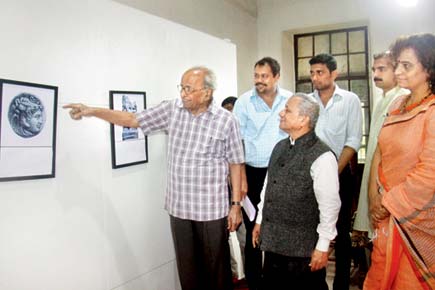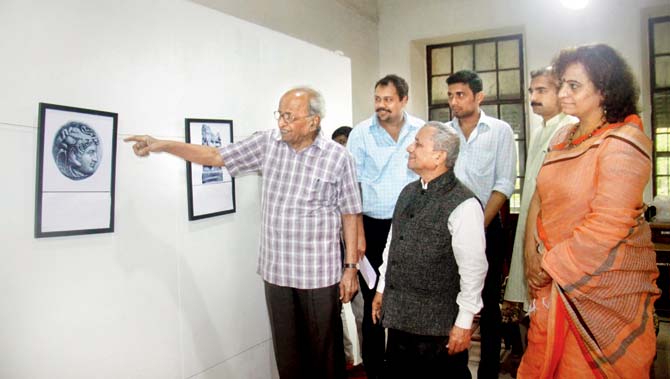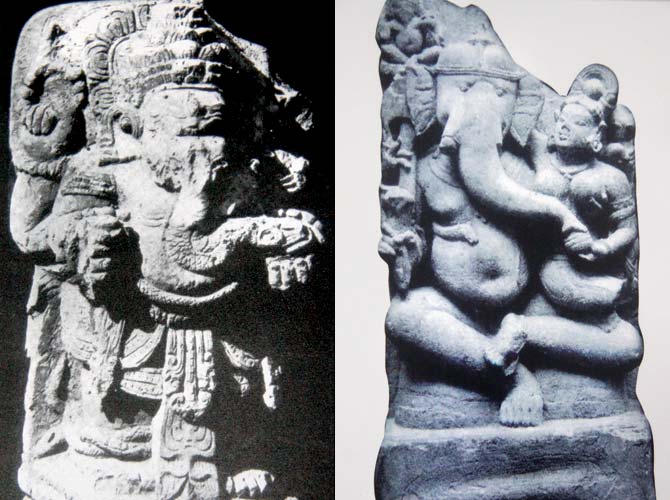As the state celebrates the 11-day Ganesha festival, a unique exhibition in Pune charts the course of the cult deity's journey from India to lands as far as Afghanistan and Vietnam as recorded by an award-winning archaeologist


Archaeologist-historian Dr Madhukhar Keshav Dhavalikar describing various representations of Ganesha across Asia at the exhibition at the Bhandarkar Oriental Research Institute. He is seen with Dr Shrikant Bahulkar, honorary secretary of the institute, who put the archaeologist’s central idea in the form of exhibits. Pics/Mandar Tannu
 God is standing on a pedestal; rather corpulent and potbellied. The head is roundish and has a third eye; the trunk is large and straight, as in Javanese representations. He wears a lower garment reaching the knees, held in place by a kamarband. He wears sparse jewellery - a necklace and bracelets, and an ornamented girdle on the waist. The tiger skin is a noteworthy feature, making this the only known instance of Ganesha wearing the vyaghra charm in all of South East Asia, although coming close to the Kabul Museum Ganesha.
God is standing on a pedestal; rather corpulent and potbellied. The head is roundish and has a third eye; the trunk is large and straight, as in Javanese representations. He wears a lower garment reaching the knees, held in place by a kamarband. He wears sparse jewellery - a necklace and bracelets, and an ornamented girdle on the waist. The tiger skin is a noteworthy feature, making this the only known instance of Ganesha wearing the vyaghra charm in all of South East Asia, although coming close to the Kabul Museum Ganesha.
ADVERTISEMENT

Ganesha in the Champa kingdom (today's Vietnam) (right) The Mahavinayak idol from Kabul, Afghanistan
Padmashree awardee and famed archaeologist-historian Dr Madhukhar Keshav Dhavalikar's description of the Ganesha at the MiSon World Heritage site in Vietnam, comes alive in an open-to-public exhibition at the Bhandarkar Oriental Research Institute in Pune starting Tuesday.

A Balinese Ganesha (right) Ganesha in an evolved avatar with Shakti: Bhumra (Madhya Pradesh)
The exhibition titled Ganesha: The God of Asia rests on 40 hi-resolution images picked from Dr Dhavalikar's book of the same name (Aryan Books International, 2016), and evokes an academic interest in the trajectory of a deity - from gaja to gana; from an animal totem to an exalted vighnaharta (obstacle-remover). At the core of the exercise lies archaeological data, employed for the first time by Dr Dhavalikar in his research and writings on Ganesha. His work on the subject dates back to the '60s. His earlier papers, titled Ganesha Beyond the Indian Frontiers and Ganesha at Mathura, are recalled as the first-ever analyses of the evolution of the Ganesha divinity.
While the Lord is the obvious cynosure of interest at the exhibition, more so because it coincides with the 11-day Ganesha festival, Dr Dhavalikar's goal is also to spark interest in diverse locales where Ganesha was carried by Indians. To quote the writer, "Indians went to different countries in spite of heavy odds; as they settled there, they gave their language, literature, script, arts, religion… but we are just blissfully unaware of it, rather we are not interested in it. And if anyone is interested, there is no source material available for study."
This exhibition promises to be the beginning of the study of 'Indian Asia' which Dr Dhavalikar feels is "so thoroughly neglected in India that it figures as a mere passing reference in textbooks."
For instance, the muscular, well-built Mahavinayak idol in Kabul, Afghanistan, demonstrates Greek-style iconographic peculiarities, dating back to the 5th century. The Paharpur image from Bangladesh (now residing in Kolkata) is a physically fit Ganesha. The idols in Sri Lanka (in the ancient city of Pollonaruwa) indicate the possibility of Indian sculptors coaching local idol makers. In Nepal, two types of Ganesha are popular - one, a dancing image and the other, a five-headed Heramb. The exhibition is like a conversation starter where the viewer is goaded into further inquiry of the Lord's journey through Myanmar, Thailand, Cambodia, Laos, Vietnam, Indonesia, Japan, China and Mongolia.
Even within India, the Lord has many residences outside Maharashtra, particularly remarkable are his avatars as the guardian deity (Dehali Vinayaka) in the city of Varanasi. The exhibition is, therefore, an elastic proposition. If it receives corporate funding and support, it can expand and open more doors for the curious observer, not just the history student. Each idol is a package in itself - it is the witness of civilizational history, a proof of the journey of Hinduism to far-off lands, the demonstration of a marriage of Hindu beliefs and idol worship with Buddhist and Jain religions (even the Tantric practitioners own up the Lord), and a confluence of sculptural styles. But most importantly, the images bring alive a loosely-knit group of disparate devotees, living geographically apart and across a continent, who experienced a similar appeal in a protuberant roly-poly figure.
As Dr Shrikant Bahulkar of the Bhandarkar Institute reiterates, the exhibition will make visitors aware of the emergence, evolution, and spread of the deity's popularity. "We thought that if the exhibition coincides with the Ganapati festival, it is more likely to catch the attention of the people. The effort is, however, of academic nature and has no direct relevance to the festival being celebrated."
At: Tata Hall, Bhandarkar Oriental Research Institute, 10 am to 8 pm, August 29 to September 3.
Sumedha Raikar-Mhatre is a culture columnist in search of the sub-text. You can reach her at sumedha.raikar@gmail.com
 Subscribe today by clicking the link and stay updated with the latest news!" Click here!
Subscribe today by clicking the link and stay updated with the latest news!" Click here!







